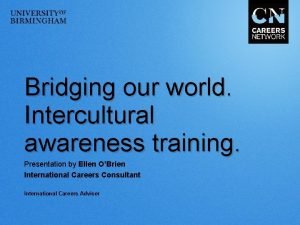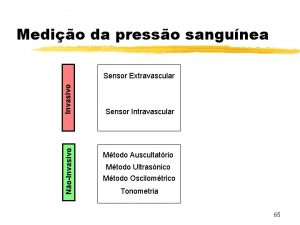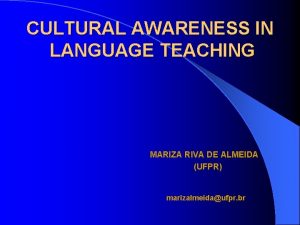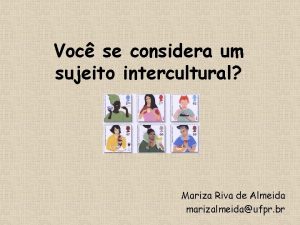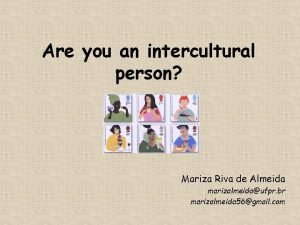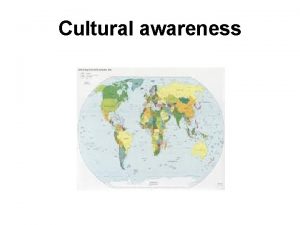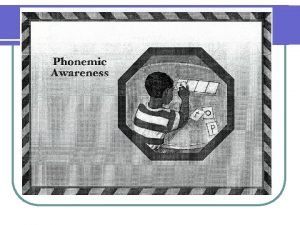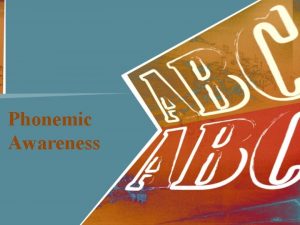CULTURAL AWARENESS IN LANGUAGE TEACHING MARIZA RIVA DE














- Slides: 14

CULTURAL AWARENESS IN LANGUAGE TEACHING MARIZA RIVA DE ALMEIDA (UFPR) marizalmeida@ufpr. br

According to the anthropologist Margaret Mead: “Culture” means human culture, the whole complex of traditional behaviour which has been developed by the human race and is successively learned by each generation. . .

A culture is less precise. It can mean the forms of traditional behaviour which are characteristic of a certain society, or of a certain area, or of a certain period of time. ” MEAD, M. Cooperation and Competition among Primitive Peoples. N. York: Mc. Graw Hill, 1973. p 17 -18

The elements of culture, according to Gail Robinson: literature folklore art institutions beliefs dress customs foods habits artefacts values leisure music

The elements of culture, according to Gail Robinson: art folklore literature music artefacts beliefs values institutions habits dress customs foods leisure

“ In fact, cultures are dynamic. They undergo growth, development and change, which makes an analysis of cultural behaviour and values challenging. Also, there is a great diversity of values, beliefs and traditions within any one culture. Every generalization has many exceptions, and especially within the multicultural societies, where a broad continuum of attitudes and opinions exists. ” Myra Shulman SHULMAN, M. Cultures in Context. Ann Harbor: The University of Michigan Press, 1998.

Some people believe that a foreign language carries within it the power to impose cultural values. Therefore, studying a foreign language would mean submitting to a foreign culture. Others see the teaching and learning of a foreign language as a way to reflect upon their own language and identity, thus creating intercultural awareness.

Why teach culture? Culture makes learning purposeful language for communication Avoid cultural misunderstandings awareness of non-linguistic communicative cues (gestures, physical contact/distance); Realisation of cultural behaviour leads to development of tolerance and better understanding of diversity, as well as to a deeper understanding of one’s own culture and behaviour; Not to change behaviour but to arise acceptance and understanding of the cultural influences affecting one’s attitudes.

BUT WITHIN DIFFERENCES!

Possible activities: 1. posters –contrasts and similarities 2. postcards – observation/judgement What is a stereotype? “A tendency to look for the typical and average; usually placed at the national level” Which kind of stereotype is being portrayed? Which cultural aspect is being hilighted?

3. punctuality Decide whether you should arrive early, on time or late for the following events in Brazil/UK: • A class • A business meeting • A date • A dinner party • A meeting with a friend

Cultural Studies – a rich and motivating language-learning resource “When trying to understand appreciate a target culture we tend to assume that our own expectations and attitudes apply. One of the fundamental concepts of cultural studies is that there is no one fixed or correct way of doing things, but there are many equally different and valid ways of living, working and worshipping. . .

The aim of Cultural Studies is to sharpen observation, encourage critical thinking about cultural stereotypes, and develop a tolerance of diversity while leading to a greater understanding of one’s own culture. In the end it is not the cultural differences that matter, but the fact that people share a common humanity”. Jack Scholes

Sites: http: //elt. britcoun. org. pl www. seed. pr. gov. br/elt Bibliographical references: MEAD, M. Cooperation and Competition among Primitive Peoples. N. York: Mc. Graw Hill, 1973. SHULMAN, M. Cultures in Context. Ann Harbor: The University of Michigan Press, 1998. MCLAREN, P. Multiculturalismo Crítico. São Paulo: Cortez, 1997. PENNYCOOK, Alastair. The Cultural Politics of English as an International Language. London: Longman, 1994.
 What is riva
What is riva Dr mariza daras
Dr mariza daras Cvs privacy awareness and hipaa training answers
Cvs privacy awareness and hipaa training answers Cultural awareness questions
Cultural awareness questions Cultural competency staircase model
Cultural competency staircase model What does cultural awareness mean
What does cultural awareness mean Cultural awareness in business communication
Cultural awareness in business communication Iehcp
Iehcp Cultural awareness training presentation
Cultural awareness training presentation Marketo microsoft dynamics crm integration
Marketo microsoft dynamics crm integration Extravascular sensor
Extravascular sensor Riva salesforce
Riva salesforce Riva rocciho metoda
Riva rocciho metoda Autoritratto picasso 1907
Autoritratto picasso 1907 Sixto muriel de la riva
Sixto muriel de la riva








